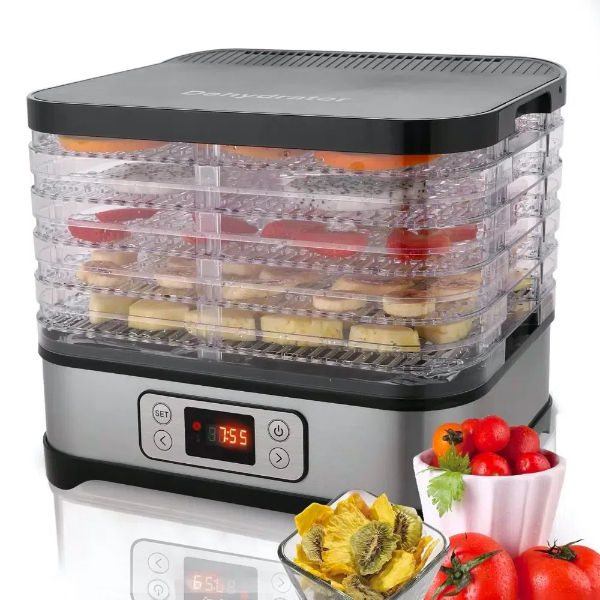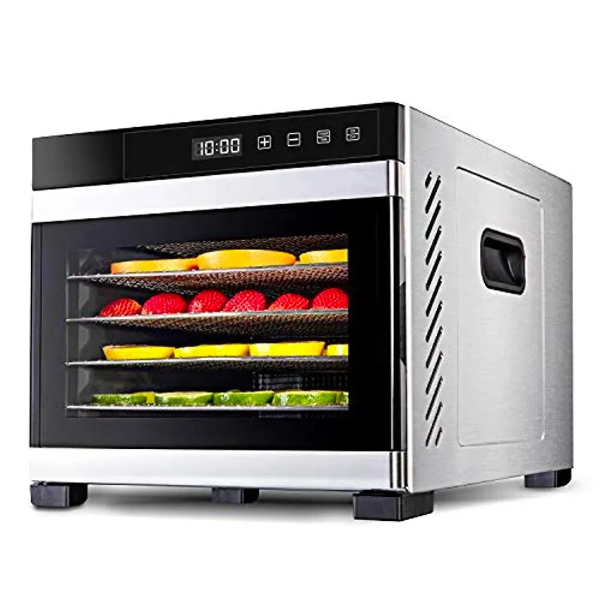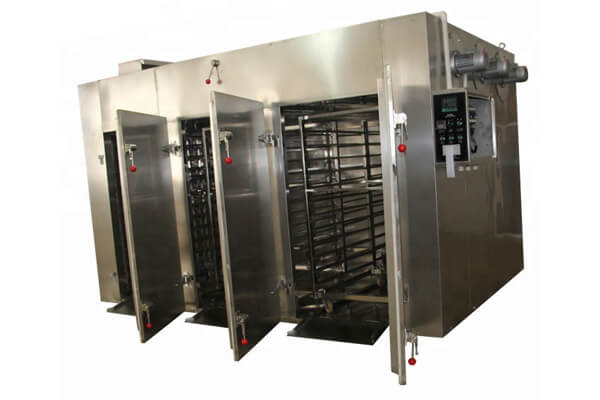
Content Menu
● Introduction to Food Drying Machines
● Types of Food Drying Machines
>> 1. Home Food Dehydrators
>> 2. Commercial Food Dryers
>> 3. Industrial Food Drying Equipment
● Key Features of Food Drying Machines
>> 1. Capacity
>> 2. Temperature Control
>> 3. Airflow System
>> 4. Timer and Auto Shut-off
>> 5. Material and Construction
● Benefits of Using Food Drying Machines
● Factors Affecting Food Drying Machine Prices
>> 1. Capacity
>> 2. Brand and Quality
>> 3. Features
>> 4. Intended Use
● Price Ranges for Food Drying Machines
>> 1. Home Food Dehydrators
>> 2. Commercial Food Dryers
>> 3. Industrial Food Drying Equipment
● Energy Efficiency and Operating Costs
● Applications of Food Drying Machines
>> 1. Home Use
>> 2. Commercial Food Production
>> 3. Agricultural Sector
>> 4. Pharmaceutical and Nutraceutical Industries
>> 5. Research and Development
● Choosing the Right Food Drying Machine
● Maintenance and Care of Food Drying Machines
● Innovations in Food Drying Technology
● Conclusion
● Frequently Asked Questions
>> 1. What is the average lifespan of a food drying machine?
>> 2. Can I use a food drying machine to make pet treats?
>> 3. How long does it take to dry food in a food drying machine?
>> 4. Are there any foods that should not be dried in a food drying machine?
>> 5. How much electricity does a food drying machine use?
Introduction to Food Drying Machines
Food drying machines, also known as food dehydrators, have become increasingly popular in recent years as people seek ways to preserve food, reduce waste, and create healthy snacks. These versatile appliances use controlled heat and airflow to remove moisture from various foods, extending their shelf life and concentrating flavors. In this comprehensive guide, we'll explore the world of food drying machines, discussing their prices, features, benefits, and applications.
Types of Food Drying Machines
Food drying machines come in various sizes and configurations to suit different needs and budgets. Let's explore the main types:
1. Home Food Dehydrators
These compact units are designed for personal or small-scale use. They typically feature multiple trays and can handle a variety of foods, from fruits and vegetables to herbs and meats. Home food dehydrators are affordable and easy to use, making them ideal for beginners and hobbyists.
2. Commercial Food Dryers
Commercial food dryers are larger, more powerful machines designed for businesses or individuals who need to process larger quantities of food. These units often have higher capacities, more precise temperature controls, and faster drying times compared to home models.
3. Industrial Food Drying Equipment
Industrial food drying equipment is used in large-scale food processing operations. These machines can handle massive quantities of food and often incorporate advanced features like automated controls, multiple drying chambers, and energy recovery systems.
Key Features of Food Drying Machines
When considering a food drying machine, it's essential to understand the key features that can impact performance and usability:
1. Capacity
Food drying machine capacity is typically measured by the number of trays or the total drying area. Home units may have 5-10 trays, while commercial and industrial models can have dozens of trays or use conveyor systems for continuous operation.
2. Temperature Control
Precise temperature control is crucial for achieving optimal results with different types of food. Look for machines that offer adjustable temperature settings, typically ranging from 95°F to 165°F (35°C to 74°C).
3. Airflow System
Efficient airflow is essential for even drying. Many food drying machines use horizontal airflow systems that distribute heat evenly across all trays. Some advanced models feature adjustable fan speeds for greater control.
4. Timer and Auto Shut-off
A built-in timer allows you to set the drying duration, while an auto shut-off feature ensures that the machine turns off once the set time has elapsed, preventing over-drying and conserving energy.
5. Material and Construction
Stainless steel food dryers are popular for their durability and ease of cleaning. Some models use BPA-free plastic components, which are lightweight but may not be as long-lasting as metal parts.

Benefits of Using Food Drying Machines
Investing in a food drying machine can offer numerous advantages:
1. Extended food shelf life
2. Preservation of nutrients and flavors
3. Reduced food waste
4. Cost savings on seasonal produce
5. Creation of healthy, preservative-free snacks
6. Compact storage of dried foods
7. Versatility in food preparation
Factors Affecting Food Drying Machine Prices
The price of a food drying machine can vary significantly based on several factors:
1. Capacity
Generally, larger capacity machines with more trays or drying space will be more expensive than smaller units.
2. Brand and Quality
Well-known brands with a reputation for quality may command higher prices, but often offer better performance and durability.
3. Features
Advanced features like digital controls, multiple fan speeds, and energy-efficient designs can increase the price of a food drying machine.
4. Intended Use
Commercial and industrial food drying equipment is typically more expensive than home-use models due to their higher capacity and more robust construction.
Price Ranges for Food Drying Machines
To give you an idea of what to expect, here's a general overview of food drying machine prices:
1. Home Food Dehydrators
- Entry-level: $30 - $80
- Mid-range: $80 - $200
- High-end: $200 - $400+
2. Commercial Food Dryers
- Small commercial: $500 - $2,000
- Medium commercial: $2,000 - $5,000
- Large commercial: $5,000 - $15,000+
3. Industrial Food Drying Equipment
- Small industrial: $15,000 - $50,000
- Medium industrial: $50,000 - $150,000
- Large industrial: $150,000 - $500,000+
It's important to note that these price ranges are approximate and can vary based on factors such as brand, features, and market conditions.

Energy Efficiency and Operating Costs
When considering the total cost of owning a food drying machine, it's essential to factor in energy consumption and operating costs. Energy-efficient food dryers may have a higher upfront cost but can lead to significant savings over time, especially for commercial and industrial users.
Some modern food drying machines incorporate heat pump technology or solar power options to reduce energy consumption. These energy-efficient models can be particularly beneficial for large-scale operations where energy costs can significantly impact profitability.
Applications of Food Drying Machines
Food drying machines have a wide range of applications across various industries and for personal use:
1. Home Use
- Creating healthy snacks like dried fruits and vegetable chips
- Preserving garden produce
- Making homemade jerky and dried meats
- Drying herbs and flowers
2. Commercial Food Production
- Producing dried fruit and vegetable products
- Creating ingredients for trail mixes and cereals
- Manufacturing pet treats and foods
- Drying herbs and spices for culinary use
3. Agricultural Sector
- Preserving excess crops during peak harvest seasons
- Creating value-added products from farm produce
- Drying seeds for storage and future planting
4. Pharmaceutical and Nutraceutical Industries
- Drying medicinal herbs and plants
- Producing powdered ingredients for supplements
5. Research and Development
- Studying the effects of dehydration on various foods
- Developing new dried food products and preservation techniques
Choosing the Right Food Drying Machine
When selecting a food drying machine, consider the following factors:
1. Intended use (home, commercial, or industrial)
2. Types of food you plan to dry
3. Desired capacity and throughput
4. Available space for the machine
5. Energy efficiency and operating costs
6. Budget constraints
7. Required features (e.g., temperature control, timer, etc.)
8. Ease of cleaning and maintenance
Maintenance and Care of Food Drying Machines
Proper maintenance is crucial for ensuring the longevity and optimal performance of your food drying machine. Here are some tips:
1. Clean the trays and interior after each use
2. Check and clean air filters regularly
3. Inspect heating elements and fans for any signs of wear
4. Calibrate temperature controls periodically
5. Follow the manufacturer's guidelines for lubrication and part replacement
Innovations in Food Drying Technology
The food drying industry continues to evolve, with new technologies and innovations emerging:
1. Smart controls and IoT integration for remote monitoring and operation
2. Improved energy recovery systems for greater efficiency
3. Hybrid drying technologies combining multiple methods (e.g., heat pump and microwave)
4. Advanced sensors for precise moisture content measurement
5. Eco-friendly materials and sustainable manufacturing processes
Conclusion
Food drying machines have come a long way from traditional sun-drying methods, offering efficient and controlled ways to preserve a wide variety of foods. Whether you're a home enthusiast looking to create healthy snacks or a large-scale food producer seeking to optimize your operations, there's a food drying machine to suit your needs and budget.
By understanding the different types of food drying machines, their features, and price ranges, you can make an informed decision when investing in this versatile technology. Remember to consider factors such as capacity, energy efficiency, and specific applications when choosing the right machine for your requirements.
As the demand for preserved foods continues to grow and technology advances, we can expect to see even more innovative and efficient food drying machines in the future. Whether you're drying fruits, vegetables, meats, or herbs, a quality food drying machine can help you preserve flavors, extend shelf life, and create delicious, nutritious products.

Frequently Asked Questions
1. What is the average lifespan of a food drying machine?
Answer: The lifespan of a food drying machine can vary depending on the quality, usage, and maintenance. On average, a well-maintained home food dehydrator can last 5-10 years, while commercial and industrial models may last 10-20 years or more with proper care and regular maintenance.
2. Can I use a food drying machine to make pet treats?
Answer: Yes, food drying machines are excellent for making homemade pet treats. You can create healthy, preservative-free treats using ingredients like meat, fruits, and vegetables. Always ensure that the ingredients are safe for pets and follow proper food safety guidelines when preparing and storing the treats.
3. How long does it take to dry food in a food drying machine?
Answer: Drying times can vary significantly depending on the type of food, its moisture content, the thickness of the slices, and the specific machine you're using. On average, fruits may take 6-16 hours, vegetables 4-12 hours, and meats 4-12 hours for jerky. Always refer to your machine's manual and recipe guidelines for specific drying times.
4. Are there any foods that should not be dried in a food drying machine?
Answer: While most foods can be safely dried, some are not recommended due to safety concerns or poor results. Foods to avoid include:
- High-fat content foods (they can become rancid)
- Dairy products
- Eggs
- Avocados
- Olives
- Foods with high water content like watermelon (results are often unsatisfactory)
Always research and follow food safety guidelines when using a food drying machine.
5. How much electricity does a food drying machine use?
Answer: The electricity consumption of a food drying machine varies based on its size, power rating, and usage duration. On average, a home food dehydrator might use between 300-1000 watts, similar to a small to medium-sized microwave oven. For a 6-8 hour drying cycle, this could translate to approximately 2-8 kWh of electricity. Commercial and industrial models will consume more power but are often more energy-efficient per unit of food dried.












